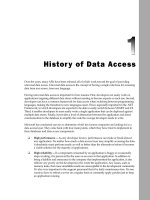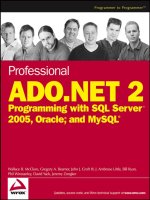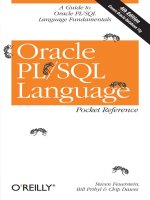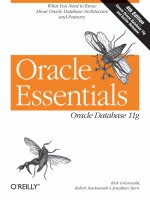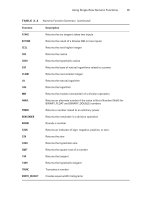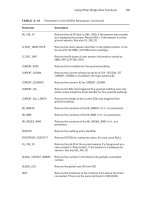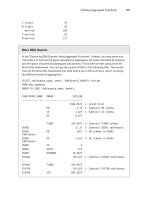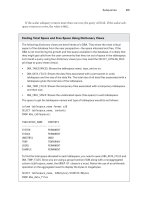Tài liệu Pro ODP.NET for Oracle Database 11g pdf
Bạn đang xem bản rút gọn của tài liệu. Xem và tải ngay bản đầy đủ của tài liệu tại đây (7.49 MB, 473 trang )
this print for content only—size & color not accurate 7.5 x 9.25 spine = x.xxx" xxx page count
Zehoo
for Oracle Database 11g
ODP .NET
The eXPeRT’s VOIce
®
In ORAcLe
Pro
ODP .NET for
Oracle Database 11g
cYAn
MAGenTA
YeLLOW
BLAcK
PAnTOne 123 c
Edmund Zehoo
Companion
eBook Available
Everything you need to work with Oracle
Database from Microsoft .NET
BOOKs fOR PROfessIOnALs BY PROfessIOnALs
®
Pro ODP .NET for Oracle Database 11g
Dear Reader,
Oracle Data Provider (ODP.NET) is a managed provider from Oracle enabling
.NET programmers to access the full feature set of the Oracle database with
speed and efficiency. Beginning with .NET 4.0, Microsoft’s own access provider
for Oracle is deprecated, making ODP.NET the clear choice for access to Oracle
from. Microsoft NET.
My goal in this book is to help you master ODP.NET by breaking the topic
into three easily digestible parts. First I explain how ODP.NET is different from
other providers and why you should use it. I walk you gently through the basics
of ODP.NET via digestible code snippets that you can quickly understand and test.
Next you’ll learn how you can tap powerful features of the Oracle database such
as Advanced Queuing, XML and UDT manipulation, globalization, distributed
transactions, and more. I show how to use these features, and how to use them
efficiently and securely. You will learn how to write lean, performance-optimized
code at every level of the data access stack.
Finally, I introduce the Oracle Developer Tools (ODT.NET) suite. ODT.NET inte-
grates seamlessly with Visual Studio to make writing and debugging easy. You’ll
even learn to generate ODP.NET applications on the fly.
I’ve had a lot of fun writing this book, and in the process I’ve re-explored and
renewed my love for a great product. If you are a .NET developer wanting to write
blazing-fast, Oracle Database applications, ODP.NET is a tool you must famil-
iarize yourself with. It is simply the fastest and most powerful way to access the
Oracle database from the .NET platform. My goal in this book is to have you wield
ODP.NET efficiently and confidently in your .NET projects. I wish you a great
journey and a fun read ahead.
Sincerely,
Edmund Zehoo
US $59.99
Shelve in:
Databases / Oracle
User level:
Intermediate–Advanced
Edmund Zehoo
THE APRESS ROADMAP
Applied Mathematics
For
Database Professionals
Pro ODP.NET for
Oracle Database 11g
Oracle
SQL Recipes
Troubleshooting
Oracle
Performance
Beginning
Oracle SQL
Beginning
Database Design
www.apress.com
SOURCE CODE ONLINE
Companion eBook
See last page for details
on $10 eBook version
ISBN 978-1-4302-2820-2
9 781430 228202
5 59 9 9
Pro
www.it-ebooks.info
www.it-ebooks.info
Pro ODP .NET for Oracle
Database 11g
Edmund Zehoo
www.it-ebooks.info
Pro ODP .NET for Oracle Database 11g
Copyright © 2010 by Edmund Zehoo
All rights reserved. No part of this work may be reproduced or transmitted in any form or by any means,
electronic or mechanical, including photocopying, recording, or by any information storage or retrieval
system, without the prior written permission of the copyright owner and the publisher.
ISBN-13 (pbk): 978-1-4302-2820-2
ISBN-13 (electronic): 978-1-4302-2821-9
Printed and bound in the United States of America 9 8 7 6 5 4 3 2 1
Trademarked names may appear in this book. Rather than use a trademark symbol with every occurrence of
a trademarked name, we use the names only in an editorial fashion and to the benefit of the trademark
owner, with no intention of infringement of the trademark.
President and Publisher: Paul Manning
Lead Editor: Jonathan Gennick
Technical Reviewer: Stephanie Lim
Editorial Board: Clay Andres, Steve Anglin, Mark Beckner, Ewan Buckingham, Gary Cornell, Jonathan
Gennick, Jonathan Hassell, Michelle Lowman, Matthew Moodie, Duncan Parkes, Jeffrey Pepper,
Frank Pohlmann, Douglas Pundick, Ben Renow-Clarke, Dominic Shakeshaft, Matt Wade, Tom
Welsh
Coordinating Editor: Anita Castro
Copy Editor: Heather Lang
Compositor: Bytheway Publishing Services
Indexer: Toma Mulligan
Artist: April Milne
Cover Designer: Anna Ishchenko
Distributed to the book trade worldwide by Springer-Verlag New York, Inc., 233 Spring Street, 6th Floor,
New York, NY 10013. Phone 1-800-SPRINGER, fax 201-348-4505, e-mail , or
visit www.springeronline.com.
For information on translations, please e-mail , or visit www.apress.com.
Apress and friends of ED books may be purchased in bulk for academic, corporate, or promotional use.
eBook versions and licenses are also available for most titles. For more information, reference our Special
Bulk Sales–eBook Licensing web page at www.apress.com/info/bulksales.
The information in this book is distributed on an “as is” basis, without warranty. Although every precaution
has been taken in the preparation of this work, neither the author(s) nor Apress shall have any liability to
any person or entity with respect to any loss or damage caused or alleged to be caused directly or indirectly
by the information contained in this work.
The source code for this book is available to readers at . You will need to answer
questions pertaining to this book in order to successfully download the code.
www.it-ebooks.info
To my family,
for you are truly all I have.
www.it-ebooks.info
CONTENTS
Contents at a Glance
Contents at a Glance iv
Contents v
About the Author xvii
About the Technical Reviewer xviii
Acknowledgments xix
Chapter 1: Introduction to Oracle .NET Connectivity 1
Chapter 2: ODP.NET: A Functional Overview 19
Chapter 3: Connecting to Oracle with ODP.NET 49
Chapter 4: Retrieving and Manipulating Data with ODP.NET 69
Chapter 5: Using PL/SQL and .NET CLR Stored Procedures with ODP.NET 117
Chapter 6: ODP.NET Globalization 161
Chapter 7: Transactions with ODP.NET 187
Chapter 8: Oracle Database Change Notifications with ODP.NET 205
Chapter 9: Using Oracle Database Streams Advanced Queuing with ODP.NET 223
Chapter 10: Oracle XML Support 253
Chapter 11: ODP.NET Security Features 287
Chapter 12: ODP.NET Performance 317
Chapter 13: Design Patterns and Considerations in Using ODP.NET 351
Chapter 14: ODT.NET Tool Basics 373
Chapter 15: Building Data-Driven Applications with ODT.NET 401
Index 429
iv
www.it-ebooks.info
Contents
Contents at a Glance iv
Contents v
About the Author xvii
About the Technical Reviewer xviii
Acknowledgments xix
Chapter 1: Introduction to Oracle .NET Connectivity 1
Making the Transition from SQL Server to Oracle 2
Introducing Oracle Connectivity 3
Accessing Oracle from Unmanaged Code 4
Using OLEDB in Unmanaged Code 5
Oracle Provider for OLEDB 5
MS OLEDB Provider for Oracle 6
Using ODBC in Unmanaged Code 6
Oracle ODBC Driver 6
Microsoft ODBC for Oracle 7
Using OO4O in Unmanaged Code 7
Accessing Oracle from Managed Code 8
Using OLEDB.NET in Managed Code 8
Using ODBC.NET in Managed Code 9
Using the Microsoft .NET Managed Provider for Oracle 11
Introducing ODP.NET 11
Understanding the ODP.NET Architecture 12
v
www.it-ebooks.info
CONTENTS
Understanding the ODP.NET Classes 12
Accessing Data using ODP.NET 13
Using ODP.NET in ASP.NET Projects 13
Considering ODP.NET Performance 15
Introducing the Oracle Suite of Products 15
Summary 17
Chapter 2: ODP.NET: A Functional Overview 19
Exploring Oracle Features Accessible in ODP.NET Version 9 19
Manipulating XML 20
Manipulating LOBs 20
Using PL/SQL Associative Array Binding 21
Supporting Active Data Objects (ADO.NET) 2.0 22
Accessing Oracle Features from ODP.NET Version 10 22
Supporting Oracle Grids 23
Supporting Multiple Oracle Homes 23
Using Floating Point Data Types 24
Using Statement Caching 24
Supporting Command Cancellation and Timeout 25
Retrieving Parameters Programmatically 26
Supporting .NET Stored Procedures 26
Using Client Identifiers 26
Using Database Change Notifications 27
Managing Connection Pools 28
Optimizing Connection Pools for RAC 28
Using a REF Cursor as an IN/OUT Parameter 29
Using 64-bit ODP.NET 29
Controlling the FetchSize Property 29
Configuring ODP.NET 30
vi
www.it-ebooks.info
CONTENTS
Accessing Oracle Features from ODP.NET Version 11 30
Enhancing Performance 31
Deploying ODP.NET Using xcopy 31
Supporting Oracle User Defined Types (UDTs) 31
Performing Bulk Copy Operations 32
Using Windows Authenticated User Connections Pooling 32
Publishing Connection Pool Performance Counters 33
Supporting Self-Tuning for Applications 34
Using Oracle Streaming AQ 34
Supporting Promotable Local Transactions 35
Using ODP.NET Security Enhancements 37
Running Callbacks for HA Event Notifications 38
Starting Up and Shutting Down Databases 38
Getting Started 39
Installing Oracle Database 11g 39
Installing ODAC.NET 43
Summary 48
Chapter 3: Connecting to Oracle with ODP.NET 49
Connecting via TNS 49
Understanding the TNSNames.ora file 51
Connecting in Other Ways 52
Connecting Without TNSNames.ora 52
Connecting via EZConnect 53
Learning the ODP.NET Connection Parameters 54
Connecting with Connection Pooling Activated 54
Connecting via Integrated Windows Authentication 57
Connecting with Special Privileges 58
Using Other Connection String Attributes 59
vii
www.it-ebooks.info
CONTENTS
Checking Whether ODP.NET Is Installed 60
Dynamically Building an ODP.NET Connection String 61
Using the OracleConnectionStringBuilder Class 61
Retrieving Available Oracle Data Sources 62
Understanding Transparent Application Failover 62
Enabling TAF in Your Application 63
Using TAF Callbacks 65
Summary 67
Chapter 4: Retrieving and Manipulating Data with ODP.NET 69
Understanding ODP.NET Data Types 69
Creating a Sample Table 73
Retrieving Multiple Rows of Data 76
Retrieving a Single Value 78
Handling NULL Values in ODP.NET 79
Retrieving Data into a Dataset 80
Using Parameterized Queries 81
Updating Data 83
Executing a Single INSERT, UPDATE, or DELETE Statement 84
Committing Dataset Changes to the Database 85
Generating Command Objects 88
Handling Master-Detail Relationships 90
Creating a Second Table 90
Retrieving from Multiple Tables 91
Binding a .NET Form to Your Dataset 92
Committing Changes to Multiple Tables 94
Defining Table Relationships and Constraints in a DataSet 95
Manipulating LOBs and BFILEs 97
viii
www.it-ebooks.info
CONTENTS
Uploading BLOB Data 97
Retrieving BLOB Data 99
Inserting CLOB/NCLOB Data 100
Retrieving CLOB/NCLOB Data 101
Creating BFILE Directory Mappings 102
Inserting BFILE Data 103
Retrieving BFILE Data 104
Manipulating RAW Data Types 105
Creating Automatically Incrementing Columns 108
Executing DDL from ODP.NET 109
Discovering Schema in ODP.NET 110
Handling ODP.NET Exceptions 113
Summary 115
Chapter 5: Using PL/SQL and .NET CLR Stored Procedures with ODP.NET 117
Understanding the Basics of PL/SQL 117
Working with Anonymous PL/SQL Blocks 118
Executing an Anonymous PL/SQL Block 118
Passing Data into an Anonymous Block 119
Returning Data from an Anonymous Block 121
Working with PL/SQL Stored Procedures 122
Executing a PL/SQL Stored Procedure 123
Passing Data into a PL/SQL Stored Procedure 124
Retrieving Data from a PL/SQL Stored Procedure 126
Executing a PL/SQL Function 127
Handling Special IN and OUT Data Types 128
Using Associative Arrays 128
Passing Associative Arrays to PL/SQL Code 129
Retrieving Associative Arrays from PL/SQL Code 131
ix
www.it-ebooks.info
CONTENTS
Using VARRAYs 134
Using Nested Tables 138
Using REF Cursors 140
Reading a Result Set from a REF Cursor Using the OracleDataReader 141
Reading a Result Set from a REF Cursor Using the OracleDataAdapter 142
Retrieving Multiple Active Result Sets 144
User Defined Types (UDT) / OBJECT Types 146
Handling Custom-Defined PL/SQL Errors 151
Creating Your First .NET CLR Stored Procedure 152
Deploying a .NET CLR Stored Procedure 154
Executing the .NET CLR Stored Procedure 157
Summary 159
Chapter 6: ODP.NET Globalization 161
Storing and Retrieving Double-Byte Data 161
Using the OracleGlobalization class 165
Setting Attributes at the Client Level 165
Setting Attributes at the Session Level 166
Setting Attributes at the Thread Level 167
Changing the Session Language 167
Formatting Calendar Dates 168
Displaying Various Date Formats and Languages 169
Designating Calendar Systems 171
Representing Currencies 172
Formatting Numbers 176
Dealing with Time Zones 176
Sorting and Comparing Strings 178
Applying Country-Based Formatting 181
Safely Mapping to .NET Data Types 183
x
www.it-ebooks.info
CONTENTS
Summary 185
Chapter 7: Transactions with ODP.NET 187
Understanding Transactions and the OracleTransaction Class 187
Executing Your First Transaction 189
Executing Stored Procedures in a Transaction 191
Performing Partial Rollbacks 192
Working with Distributed Transactions 194
Creating a Second Database Instance 195
Executing Implicit Distributed Transactions 198
Executing Explicit Distributed Transactions 201
Executing Promotable Transactions 202
Summary 203
Chapter 8: Oracle Database Change Notifications with ODP.NET 205
Understanding Database Change Notification 205
Registering for Query-Based Change Notifications 206
Registering for Object-Based Change Notifications 211
Grouping Multiple Notification Requests 212
Removing a Registration 213
Retrieving Change Notification Information 214
Choosing to Poll 216
Considering Typical Usage Scenarios 217
Thinking About Performance 221
Summary 222
Chapter 9: Using Oracle Database Streams Advanced Queuing with ODP.NET 223
Understanding the Basics of AQ 224
Creating a Single-Consumer Queue 224
Setting Up a Single-Consumer Queue 224
xi
www.it-ebooks.info
CONTENTS
Enqueuing and Dequeuing a Single Message 226
Enqueuing and Dequeuing Multiple Messages 230
Creating a Multiple-Consumer Queue 232
Defining Recipients at the Queue Level 233
Defining Recipients at the Message Level 237
Enqueuing and Dequeuing Various Data Types in AQ 238
Using UDT Data Types 238
Using XML Data Types 244
Waiting for Incoming Messages 246
Dequeuing Messages Synchronously (Blocking) 247
Dequeuing Messages Asynchronously (Nonblocking) 248
Understanding the Useful OracleAQMessage Properties 250
Summary 251
Chapter 10: Oracle XML Support 253
Accessing Native XML Data (XMLTYPE) 254
Creating an XMLTYPE Column 254
Receiving XMLTYPE Data with XMLReader 255
Receiving XMLTYPE Data with OracleXMLType 257
Receiving XMLTYPE Data as a String 259
Passing XML Data to and from PL/SQL Stored Procedures 260
Validating Against XML Schema 262
Using XSLT to Transform XML Data 266
Retrieving Relational Data as XML 269
Using the XMLCommandType property 269
Using the Dataset.GetXML Method 272
Using the DBMS_XMLGEN.GETXML Stored Procedure 273
Manipulating Relational Data as XML 274
Inserting Relational Data Using XML 274
xii
www.it-ebooks.info
CONTENTS
Updating Relational Data Using XML 278
Deleting Relational Data Using XML 280
Using XQuery to Query Data 282
Summary 284
Chapter 11: ODP.NET Security Features 287
Securing Your .NET Applications 287
Authenticating Data 289
Implementing Username/Password Authentication 289
Implementing Proxy Authentication 289
Implementing ClientId-Based Username/Password Authentication 290
Implementing Windows Authentication 291
Understanding Code Access Security 291
Using Code Groups 292
Using Permission Sets 293
Resolving Permissions in .NET 294
Seeing CAS in Action 295
Configuring CAS Policies 297
Configuring CAS Policies via the GUI 297
Configuring CAS Policies Programmatically 301
Requesting Permissions 301
Requesting Permissions Declaratively 301
Requesting Permissions Imperatively 304
Ensuring That an Assembly Can Never Access Oracle 305
Refusing Permissions Declaratively at the Assembly Level 306
Denying Permissions Declaratively at the Method Level 307
Denying Permissions Imperatively at the Method Level 308
Using CAS with ASP.NET Applications 308
Implementing Best Practices 313
xiii
www.it-ebooks.info
CONTENTS
Preventing SQL Injection Attacks 313
Preventing Nonpersistent Cross-Site Scripting Attacks 314
Summary 315
Chapter 12: ODP.NET Performance 317
Measuring Performance 317
Enabling the Performance Counters 318
Measuring Performance Programmatically 320
Speeding Up Connections with Connection Pooling 321
Performing Faster Floating Point Arithmetic 323
Executing Statements Faster 325
Batching Your SQL Statements Together For Execution 325
Using Statement Caching 328
REF Cursors and Multiple Active Resultsets (MARs) 331
Passing Parameters More Efficiently 331
Using Bind Arrays to Pass Parameters in Bulk 331
Using PL/SQL Associative Arrays 334
Managing LOBs More Efficiently 337
Enabling the LOB Cache 337
Setting the InitialLOBFetchSize Property 340
Retrieving Data More Efficiently 341
Changing the FetchSize Property 341
Using the Client Result Cache 343
Importing Data More Efficiently 346
Applying Optimization Best Practices 348
Using Stored Procedures Whenever Possible 349
Using the Right Data Access Object 349
Summary 349
xiv
www.it-ebooks.info
CONTENTS
Chapter 13: Design Patterns and Considerations in Using ODP.NET 351
Programming to an Interface Instead of an Implementation 352
Using the Data Access Object 353
Using Microsoft’s Enterprise Library 354
Creating Oracle.NET 355
Creating the ODP.NET DAO Class 355
Modifying the DBProviderMapping Class 361
Modifying the DatabaseConfigurationView Class 362
Compiling the New DAAB 364
Using the ODP.NET DAO 364
Editing the Application Configuration File 364
Accessing Data via the DAAB 366
Reading Multiple Rows into a Dataset 366
Updating Multiple Rows from a Dataset 367
Reading Data Using a DataReader 368
Considering Best Practices 369
Planning for Multiple Data Sources 369
Keeping Provider-Specific Code Within the Data Tier 369
Outputting Business Objects, Not Datasets 370
Deciding How to Map Data Source Structures to Business Objects 370
Deciding How to Manage Data Source Settings 370
Summary 370
Chapter 14: ODT.NET Tool Basics 373
Installing ODT.NET 373
Managing the Database Schema 374
Managing Users, Roles, and Object Privileges 377
Editing and Debugging PL/SQL Code 380
Creating a PL/SQL Procedure 380
xv
www.it-ebooks.info
CONTENTS
xvi
Creating a PL/SQL Package 383
Debugging PL/SQL stored procedures 385
Managing Oracle SQL Scripts 391
Managing Advanced Queues 394
Importing Tables and Data from External Data Sources 396
Summary 399
Chapter 15: Building Data-Driven Applications with ODT.NET 401
Designing Queries Visually 401
Generating Strongly Typed DataSet Objects 404
Generating UDT Classes 413
Designing a UDT Object Visually 413
Creating the UDT Object Table Visually 414
Creating the OVERSEAS_JOBS Table 415
Generating the UDT Classes 417
Using the UDT in Your Project 420
Generating ASP.NET Code 423
Summary 427
Index 429
www.it-ebooks.info
About the Author
Edmund Tan Zehoo is the Chief Technical Officer of an e-forms and
workflows solution vendor based in Singapore. He took the role of lead
architect in the design of several workflow products, one of the most
popular being the Quickflows product. He has also spent the last eight
years building performance critical .NET e-forms and workflows solutions
hosted on top of Oracle databases for large companies and governmental
institutions in Singapore.
Edmund is a frequent speaker at various workflow conferences held in
Singapore and Malaysia, and continually preaches about the synergistic
power of using Oracle with the .NET framework. During his free time he
can often be found engaging in his favourite pastime exploring the
innerworkings of the brain and mind, with the ultimate goal of writing
intelligent software to emulate the behavior of the mind. He is also an avid
believer in the Technological Singularity.
xvii
www.it-ebooks.info
About the Technical Reviewer
Stephanie Lim is an accomplished .NET developer who has worked on major Oracle database projects
in Indonesia, Singapore and Malaysia. She is well versed with ODP.NET and can often be found
programming on her laptop in her free time. When not programming, she enjoys making handcrafts and
a good bed-time novel. She also somehow manages to find time for her Schnoodle “Sticky” after work.
xviii
www.it-ebooks.info
Acknowledgments
This book is the result of the combined efforts of a team of wonderful people I’ve had the pleasure of
working with. I’ll start with a special word of thanks to my editor Jonathan Gennick - thanks for giving
this author halfway around the world a chance. Your encouraging remarks and insightful edits
constantly remind me that authoring a book can indeed be so much fun.
My heartfelt gratitude also goes out to Anita Castro for her timekeeping and the always cheerful e-mails,
Heather Lang for making me sound so much better in print, Dominic Shakeshaft and the Apress editorial
board for giving me a shot at this book, and all the other Apress team members who’ve contributed to
this book.
I also thank my good friend Greg Yap for his code contributions and his scrutinizing eye on my every
sentence in the book, and also Hui Shen for her great (and sometimes tough) reviews.
Last and definitely not least, I have a small but fiercely-loving family that I would like to individually
thank - my mom and late dad for being the greatest parents one could ever hope for, my late godmother
for instilling the bookworm in me, my brother and sister for their silly jokes and the two persons who’ve
suffered most during this project – my wife and daughter who’ve had to put up without a husband and
father for 8 months – thank you for being the understanding family I knew you’d be.
xix
www.it-ebooks.info
www.it-ebooks.info
C H A P T E R 1
Introduction to Oracle
.NET Connectivity
The release of Oracle Database 11g, and more recently, revision R2 offers up a trove of advanced Oracle
database functionality ranging from features like database change notifications to performance boosts
like query result caching. As new features are added, the functionality you could achieve with the
database increased manifold, but what you, as a .NET developer, could do using Microsoft’s ADO.NET
and OLEDB.NET technologies were still quite limited. Without native access to the database, NET
developers could not tap onto many of these Oracle-specific features that would otherwise allow them to
fine-tune data access performance. To many, it was like being in a racecar stuck in first gear.
Fortunately, both Microsoft and Oracle have released providers that enable .NET developers to write
applications that are more tightly integrated with the Oracle database. Microsoft released the .NET
Managed Provider for Oracle, and Oracle released the Oracle Data Provider for .NET (ODP.NET). These
data providers were different from the rest in that they communicated directly with the native Oracle
Call Interface (OCI) application programmer interface (API) and exposed a larger set of the native
functionality in Oracle.
Note: The OCI is Oracle’s native interface—the most direct method to talk to an Oracle database. Calls made
via other interfaces such as JDBC, ADO.NET, and even ODP.NET all translate into OCI calls. Even Oracle’s own
management tools ultimately depend on the OCI. Thus, the OCI can be relied on to expose all possible functionality
in Oracle.
With Microsoft’s .NET Managed Provider for Oracle recently deprecated, .NET developers are now
turning to ODP.NET, the managed provider from Oracle that offers exceptional performance and yet
exposes all the advanced Oracle functionality you need to create compelling applications.
This first chapter aims to introduce to you the ODP.NET library. It also takes a look at Oracle
connectivity in general (from managed and unmanaged code) using the other data access methods
available and provides an overview of how they measure up to each other in terms of performance. You
will learn the following:
• A breakdown of the Oracle suite of products
• The main differences between Oracle 11g and SQL Server 2008
1
www.it-ebooks.info
CHAPTER 1 INTRODUCTION TO ORACLE .NET CONNECTIVITY
• The various managed and unmanaged providers used to connect to an Oracle database and how
they differ architecturally and in terms of performance
Making the Transition from SQL Server to Oracle
If you’re one of those moving from Microsoft SQL Server to Oracle, you’re probably curious about what
their differences are and what those would mean to you as a .NET developer. Although there are still
some major feature differences between the latest versions of these two databases, the recently released
Microsoft SQL Server 2008 has been a large step toward achieving the range of functionality available in
Oracle 11g. For instance, Microsoft has introduced Transparent Data Encryption (a technology that
encrypts the database without requiring any additional code to be written) with SQL Server 2008, a
feature that also exists in Oracle 11g.
The biggest change in moving to Oracle would be the SQL dialect that is used to query the database.
Oracle uses its own dialect called PL/SQL, and at times, that can be drastically different from T-SQL in
SQL Server. Even in its simplest form, there are still many tiny SQL differences to watch out for when
writing SQL statements and stored procedures on Oracle. For instance, Oracle uses the double quotation
mark to handle whitespace in table column names while SQL Server uses the square brackets. Listing 1-1
shows the difference. The PL/SQL language itself would fill up an entire book on its own and will not be
covered in this book. To maximize your usage of ODP.NET, it is recommended to at least familiarize
yourself with the basics of PL/SQL.
Listing 1-1. SQL Syntax Difference Between SQL Server and Oracle
SQL SERVER
SELECT [Full Price] FROM [Global Products]
ORACLE
SELECT "Full Price" FROM "Global Products"
Another difference to note is that Oracle provides numerous advanced data types and cursors that
can boost query performances if used correctly. For instance, Oracle provides the LOB data types that
perform faster than the standard LONG data types used for storing large objects. We will cover more
ground on accessing these data types via ODP.NET in the later chapters of this book.
There are, of course, many other differences between these two databases from a database
administrator’s point of view, but we will only account for the major differences that affect .NET
development. This list is briefly summarized in Table 1-1.
Table 1-1. Major Differences Between Oracle and SQL Server
Oracle Microsoft SQL Server
Supports most known platforms including
Windows-based platforms and AIX-based and
HP-UX–based systems
Supports only Windows-based platforms
Provides the PL/SQL language, which is more
powerful than T-SQL. For example, PL/SQL
Provides the T-SQL language
2
www.it-ebooks.info
CHAPTER 1 INTRODUCTION TO ORACLE .NET CONNECTIVITY
supports the usage of arrays (called associative
arrays), nested tables as well as Java methods
in its declaration
Enables the developer to control the client
result cache (an area of client-side memory
allocated to cache query results to fine-tune
performance
No equivalent functionality available
Provides push database change notifications
that can raise events directly in .NET code
No equivalent functionality available
Supports the use of REF cursors that allow the
developer to reference a result set directly in
memory, thereby optimizing data retrieval
No equivalent functionality available
Supports collection data types such as VARRAY
tables and nested data tables as column data
types
No equivalent functionality available
Message queuing is achieved at the database
level through Oracle Advanced Queuing
The closest equivalent is Microsoft
Messaging Queue Server (MSMQ), which
is an entirely different product and not
implemented at the database level.
Introducing Oracle Connectivity
The Oracle database has seen many revisions since its inception and has grown into a fairly complicated
(but powerful) database product. There are at least five different ways to access the database from
unmanaged code and another six ways to access it from managed code!
In my conversations with developers starting out in Oracle development, the most frequent
question I hear is, “Which data access provider yields the best performance?” My take on this question
has always been that you should look not just at performance alone but also the accessible feature set of
the database. You also need to consider how generic your data tier code needs to be in your application,
because some providers, like the Oracle Objects for OLE (OO4O) provider, do not use ADO/ADO.NET
but instead use a proprietary set of classes to access the database. In short, it all depends on what you
need for your project.
As an example, if you needed to receive Oracle database change notifications in your project, you
would be better off using ODP.NET instead of OLEDB.NET. And if your legacy Visual Basic 6 (VB6)
project only ever needed to use Oracle but had to run at the fastest speed possible, OO4O would be a
good choice.
With all the different terminology and providers from both Microsoft and Oracle, it’s easy to confuse
the various providers available, or worse, choose the wrong one in your project only to realize its
limitations midway during development.
The following sections list all the data providers (managed and unmanaged) available to you and
explain their performance and feature set differences. They also explain how these data providers are
architecturally arranged in the data access stack.
3
www.it-ebooks.info


